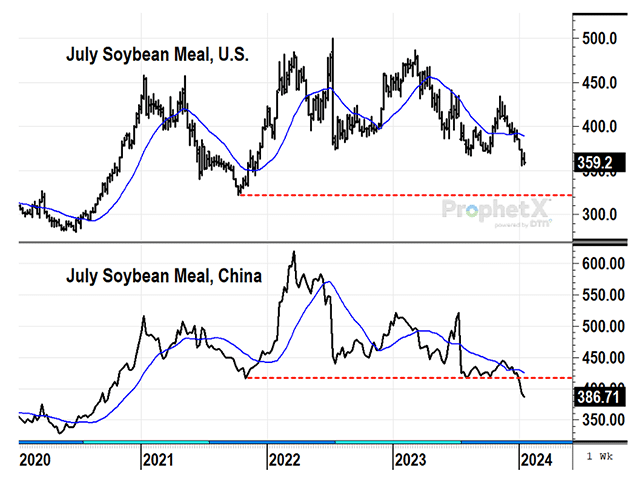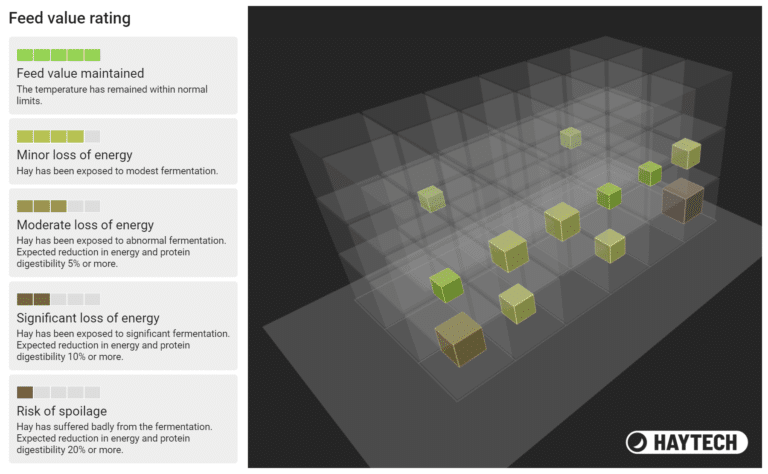Nutritional value of hay: Reduce your feed supplements cost
Whether you’re tending to a herd of cattle, nurturing dairy cows, or caring for horses, nutritional value of hay and straw plays a pivotal role in your animals’ nutritional regime. At Quanturi, we’ve discovered that delving deeper into your hay and straw stacks can unlock even greater benefits.
Let’s explore how this deeper understanding translates into tangible advantages and why we believe it’s crucial to understand the nutritional value of your hay bales now more than ever.
Table of Contents
A comparison of nutritional value: Hay versus other livestock feeding options
The most naturally balanced diet for your stock is undoubtedly grass. A well-maintained pasture offers a blend of fibre, energy, proteins, and sugars aligning with the needs of your stock. But what happens when your pasture isn’t delivering?
Introducing corn silage has certainly permitted a boost in production, but the very nature of using the corn silage created new challenges. Corn silage, while rich in energy, lacks adequate protein which means for you the need to supplement with expensive soymeal. In practical terms this means you need to add on average 1kg of soymeal for every 10kg of corn silage to the diet, to meet the nutritional needs of your animals.
Considering the fluctuating price of soymeal over the past few years (see below image), relying on this source of protein to nourish your livestock becomes more precarious.

Image source: DTN ProphetX chart by Todd Hultman
But I have good news, amidst these issues there is a silver lining! Here at Quanturi we believe that you can get more nutritional value from your hay stores then you currently may be. Derived from grasses and legumes, hay inherently has a well-balanced nutritional value, providing everything to get your livestock to thrive, so how do you take advantage of it is the question.
As I am sure you are aware Alfalfa hay is gaining popularity for many good reasons. Its high protein content makes it a viable option for livestock. Additionally, its remarkable harvest frequency – up to 6 times a year or more, depending on climate variables – make it a highly efficient choice for farmers.
Depending on the unique composition of your soil and the prevailing climatic conditions, you can craft a tailored blend of grasses and legumes perfectly suited from your fields for your livestock. This custom mix will inherently possess a balance of nutrients essential for your animals, requiring no additional supplements for optimal nourishment.
How much money can you save by maintaining the nutritional value of hay?
Whether the grassland is being grazed or harvested for hay, the nutrients it produces are playing an integral part in meeting your livestock’s nutritional requirements. Even when you are using corn silage as the main feeding source for your dairy cows, you could expect to save money thanks to your hay quality.
Switching from straw to good quality hay in the ration can allow you to save up to 300g of soymeal per cow and per day for the same production. For a dairy farm with 50 milking cows, this represents more than $1,700 savings per year!
The better the quality of the feed, the more money you will save in theory. As I am sure you know- quality hay is palatable, which means happy cows. A quality hay is rich in protein, sugars, and fibres, thus protecting your animals’ health. However, a quality hay is also a young hay, which can be prone to fermentation due to its rich nutritional content or moisture level meaning there is a higher chance of spoilage.
The fermentation of hay needs to be avoided, to ensure its nutritional content is not degraded between the harvest and its use for feeding and in turn not cut into your margins. The more nutrients lost during this storage period, the more money you will have to spend on concentrates to maintain your production in the future.
Feed smart, farm better- How do we do that?
We, at Quanturi, have developed an interest in solving this challenge and through years of data collection developed a tool to meet such a demand- Feed Value Indicator (FVI). We have created a tool which can quantify the fermentation process and warn you when your bales are losing nutrients, giving you the information to manage your stack efficiently.
The Feed Value Indicator (FVI) is based and supported by publications released in the Journal of Dairy Science and studies from the Australian Department of Primary Industries, which have established a quantitative link between the temperature variations in the bales and the lost nutrients.
Thanks to our pilot farms, located throughout Europe and the UK, we have compared the theory with the results from the field and created our own model to provide our customers with additional benefits within the HAYTECH system.
HAYTECH Feed Value Indicator

On a practical level, by simply utilizing the HAYTECH probes, which have been inserted into your hay bales, you will receive notifications on your phone or desktop up to a week before the hay nutritional value starts decreasing. These notifications can be used in two ways:
- You can visualize how your entire supply is doing and decide to feed first the hay that is prone to degradation, so you don’t lose many nutrients in the process.
- You have an estimation of how much has been degraded, so you can balance your livestock’s ration accordingly.
In an era marked by significant price fluctuations in imported food, reducing the reliance on external sources of protein and energy for livestock is critical for steering and optimizing your production costs. The FVI and the Quanturi app offer such a solution to help achieve this lofty goal in a smart and simple way which empowers the farmer to make the right decisions.
References
Coblentz, W.K., and P.C. Hoffman. ‘Effects of Spontaneous Heating on Estimates of Total Digestible Nutrients for Alfalfa-Orchardgrass Hays Packaged in Large Round Bales’. Journal of Dairy Science 93, no. 7 (July 2010): 3377–89. https://doi.org/10.3168/jds.2010-3133.
Coblentz, W.K., and P.C. Hoffman. ‘Effects of Spontaneous Heating on Fiber Composition, Fiber Digestibility, and in Situ Disappearance Kinetics of Neutral Detergent Fiber for Alfalfa-Orchardgrass Hays’. Journal of Dairy Science 92, no. 6 (June 2009): 2875–95. https://doi.org/10.3168/jds.2008-1921.
Griffiths, Neil, John Piltz, Edward Clayton, Richard Meyer, and Scott Richards. ‘Effect of Heating on Feed Value of Hay’. NSW Government, Primary Industries, June 2011. https://www.dpi.nsw.gov.au/__data/assets/pdf_file/0007/395188/Effect-of-heating-on-feed-value-of-hay.pdf.
Authors

Marie Huyghe
Author
Agronomist Quanturi Oy

Brett Saxby
Reviewer
VP sales and Marketing Quanturi Oy